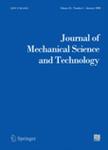版权所有:内蒙古大学图书馆 技术提供:维普资讯• 智图
内蒙古自治区呼和浩特市赛罕区大学西街235号 邮编: 010021

作者机构:Sharif Univ Technol Sch Sci & Engn Tehran Iran Shahid Bahonar Univ Kerman Dept Mech Engn Kerman Iran
出 版 物:《JOURNAL OF MECHANICAL SCIENCE AND TECHNOLOGY》 (韩国机械工程师学会国际杂志)
年 卷 期:2012年第26卷第8期
页 面:2459-2467页
核心收录:
基 金:School of Science and Engineering of Sharif University of Technology
主 题:Clipped optimal algorithm Inverse model MR damper Neural network Semi-active control Suspension system
摘 要:A semi-active controller-based neural network for a suspension system with magnetorheological (MR) dampers is presented and evaluated. An inverse neural network model (NIMR) is constructed to replicate the inverse dynamics of the MR damper. The typical control strategies are linear quadratic regulator (LQR) and linear quadratic gaussian (LQG) controllers with a clipped optimal control algorithm, while inherent time-delay and non-linear properties of MR damper lie in these strategies. LQR part of LQG controller is also designed to produce the optimal control force. The LQG controller and the NIMR models are linked to control the system. The effectiveness of the NIMR is illustrated and verified using simulated responses of a full-car model. The results demonstrate that by using the NIMR model, the MR damper force can be commanded to follow closely the desirable optimal control force. The results also show that the control system is effective and achieves better performance and less control effort than the optimal in improving the service life of the suspension system and the ride comfort of a car.